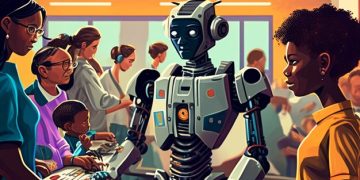AI Automation’s Impact: Reshaping US Jobs by 2026

AI-powered automation is poised to significantly reshape US jobs by 2026, impacting various sectors and requiring workforce adaptation through reskilling and upskilling initiatives.
The future of work in the US is rapidly evolving, largely driven by the increasing integration of artificial intelligence (AI) and automation technologies. By 2026, AI-powered automation will have significantly reshaped the landscape of US jobs, creating new opportunities while also posing challenges to the existing workforce.
The Rise of AI and Automation in the Workplace
The increasing prevalence of AI and automation in the workplace is not a futuristic fantasy but a rapidly unfolding reality. These technologies are being implemented across various industries, transforming how tasks are performed and impacting the roles of human workers.
Current Trends in AI Implementation
AI is already being used in numerous ways, from automating repetitive tasks to providing data-driven insights for decision-making. This widespread adoption signifies a fundamental shift in how businesses operate and the skills they require from their employees.
Examples of Automation in Different Sectors
In manufacturing, robots are performing assembly-line tasks with greater precision and speed. In customer service, chatbots are handling routine inquiries, freeing up human agents for more complex issues. These examples illustrate the diverse applications of automation across different sectors.
- Manufacturing: Automation enhances production efficiency and reduces costs.
- Customer Service: AI-powered chatbots provide instant support and personalized experiences.
- Healthcare: AI assists in diagnosing diseases and personalizing treatment plans.
The integration of AI and automation is fundamentally altering the skill sets needed in the workforce. As machines take over routine tasks, human workers are expected to focus on roles that require creativity, critical thinking, and emotional intelligence.

The rise of AI and automation in the workplace represents a significant shift in the dynamics of the US job market, necessitating proactive strategies for workforce adaptation and skills development.
Projected Job Displacement and Creation
One of the primary concerns surrounding AI and automation is their potential to displace existing jobs. However, alongside job displacement, these technologies are also expected to create new job opportunities, leading to a transformation of the overall job market.
Industries at High Risk of Job Displacement
Certain industries, such as manufacturing, transportation, and data entry, face a higher risk of job displacement due to the ability of AI and automation to perform routine and repetitive tasks more efficiently than humans. Understanding which industries are most at risk is crucial for developing targeted strategies to mitigate potential negative impacts.
Emerging Job Roles in the AI Era
While some jobs may be displaced, new roles are emerging in areas such as AI development, data science, and AI maintenance. These roles require specialized skills and knowledge, highlighting the need for education and training programs to prepare the workforce for these opportunities.
- AI Development: Creating and improving AI algorithms and systems.
- Data Science: Analyzing large datasets to extract valuable insights.
- AI Maintenance: Ensuring the proper functioning and security of AI systems.
The impact of AI and automation on the job market will not be uniform across all sectors. Some industries may experience significant job losses, while others may see a net increase in employment opportunities. The key is to understand these trends and prepare the workforce accordingly.
The projected job displacement and creation driven by AI and automation underscore the importance of proactive measures such as reskilling and upskilling initiatives to ensure that the workforce can adapt to the evolving demands of the job market.
Skills in Demand: Preparing for 2026
As AI and automation transform the job market, the demand for certain skills will increase significantly. Preparing the workforce for 2026 requires a focus on developing skills that complement AI, rather than compete with it.
Technical Skills for the Future
Technical skills such as AI programming, data analysis, and cybersecurity will be highly sought after. Acquiring these skills will enable workers to participate in the development, implementation, and maintenance of AI systems.
Soft Skills: The Human Advantage
Soft skills such as critical thinking, creativity, and emotional intelligence will become even more valuable in the AI era. These skills are difficult to automate and are essential for roles that require problem-solving, innovation, and interpersonal interaction.
- Critical Thinking: Analyzing information and making informed decisions.
- Creativity: Generating new ideas and innovative solutions.
- Emotional Intelligence: Understanding and managing emotions, and building relationships.
Education and training programs must adapt to the changing skill requirements of the job market. By focusing on both technical and soft skills, these programs can help workers remain competitive and thrive in the AI-driven economy.

The skills in demand for 2026 reflect a shift towards roles that require a combination of technical expertise and human qualities, emphasizing the need for a holistic approach to workforce development.
Education and Training Initiatives
To prepare the US workforce for the changes brought about by AI and automation, robust education and training initiatives are essential. These initiatives should focus on providing access to relevant skills development opportunities for workers of all backgrounds.
Government Programs and Funding
Government programs play a crucial role in supporting reskilling and upskilling initiatives. Funding for training programs, apprenticeships, and educational grants can help individuals acquire the skills they need to succeed in the AI-driven economy.
Corporate Training and Development
Companies should invest in training and development programs for their employees, providing them with the skills necessary to work alongside AI systems and adapt to changing job roles. This can include on-the-job training, online courses, and mentorship programs.
Collaboration between government, industry, and educational institutions is vital for creating effective education and training initiatives. By working together, these stakeholders can ensure that the workforce is equipped with the skills needed to thrive in the future of work.
Education and training initiatives are critical for mitigating the potential negative impacts of AI and automation on the workforce and ensuring that individuals have the opportunity to participate in the new economy.
Policy and Ethical Considerations
As AI and automation become more prevalent in the workplace, policymakers and businesses must address ethical and societal implications. These considerations are essential for ensuring that AI is used responsibly and that the benefits are shared equitably.
Addressing Job Displacement Concerns
To mitigate the negative impacts of job displacement, policies should focus on providing support for affected workers, such as unemployment benefits, job retraining programs, and income support measures. These policies can help individuals transition to new roles and maintain their economic security.
Ensuring Fairness and Equity
AI systems should be designed and implemented in a way that promotes fairness and equity. This includes addressing potential biases in AI algorithms and ensuring that all individuals have equal access to opportunities in the AI-driven economy.
Ethical guidelines and regulations are needed to govern the development and use of AI in the workplace. These guidelines can help ensure that AI is used in a way that respects human rights, promotes fairness, and minimizes potential harm.
Policy and ethical considerations are critical for navigating the complex challenges posed by AI and automation and ensuring that these technologies are used in a way that benefits society as a whole.
Case Studies: Successful AI Integration
Examining case studies of companies that have successfully integrated AI and automation can provide valuable insights into best practices and strategies for workforce adaptation. These examples can help other organizations navigate the challenges and opportunities of the AI-driven economy.
Company A: Enhancing Productivity with AI
Company A implemented AI-powered automation in its manufacturing processes, resulting in increased productivity and reduced costs. By providing training and support to its employees, the company was able to successfully transition workers to new roles that required higher-level skills.
Company B: Improving Customer Experience with AI
Company B used AI-powered chatbots to enhance its customer service operations, providing instant support and personalized experiences to its customers. This allowed the company to free up human agents to focus on more complex customer inquiries and improve overall customer satisfaction.
These case studies demonstrate that successful integration of AI and automation requires a holistic approach that considers both technological and human factors. By investing in employee training, addressing ethical concerns, and focusing on creating value for customers, organizations can reap the benefits of AI while minimizing potential negative impacts.
The success stories of companies that have effectively integrated AI and automation highlight the importance of proactive planning, employee engagement, and a commitment to ethical and responsible AI practices.
| Key Point | Brief Description |
|---|---|
| 🤖 AI Integration | AI and automation are increasingly integrated across various industries. |
| 💼 Job Displacement | Some industries face potential job losses due to automation. |
| 🚀 Emerging Roles | New job roles are emerging in AI development and data science. |
| 📚 Skill Development | Reskilling and upskilling initiatives are crucial for workforce adaptation. |
Frequently Asked Questions
▼
AI is expected to automate some jobs, particularly those involving repetitive tasks, leading to potential job displacement in certain sectors. However, it will also create new opportunities requiring different skill sets.
▼
Technical skills such as AI programming and data analysis will be highly valued, as well as soft skills like critical thinking, creativity, and emotional intelligence, which are harder to automate.
▼
Ethical concerns include addressing job displacement, ensuring fairness and equity in AI systems, and establishing guidelines to govern AI development and use. Transparency and accountability are key.
▼
Governments can offer funding for training programs and unemployment benefits. Companies should invest in employee training, provide resources for skill development, and support workers through the transition to new roles.
▼
Industries such as manufacturing, transportation, customer service, and data entry are likely to be significantly impacted by AI and automation due to the automation of routine tasks. Healthcare will also see increasing AI integration.
Conclusion
As we look towards 2026, the integration of AI-powered automation will profoundly reshape the US job market, presenting both challenges and opportunities. By focusing on education, ethical considerations, and proactive policies, we can navigate this transformation and create a future of work that benefits all.





